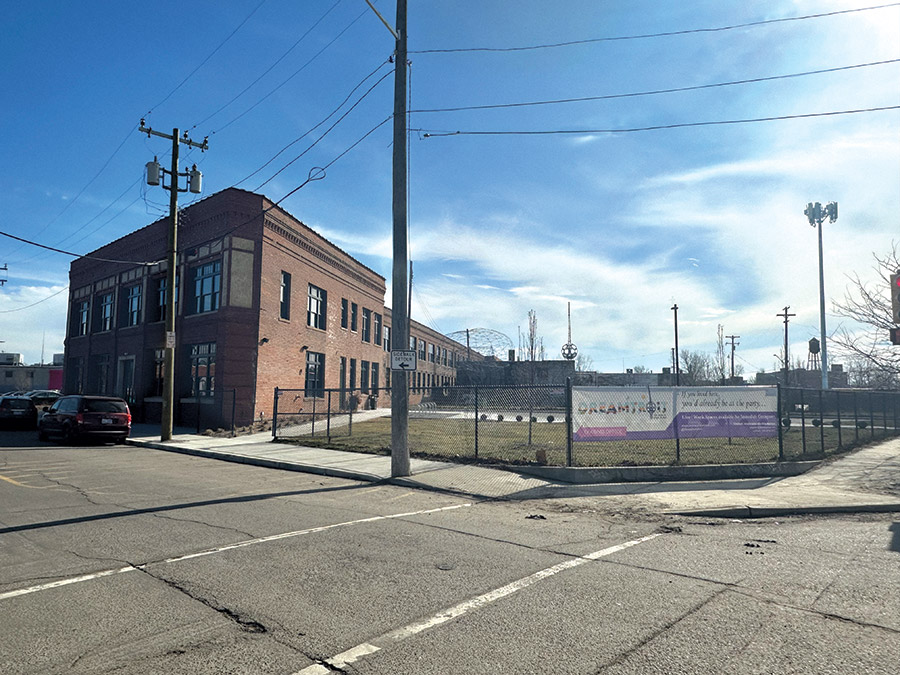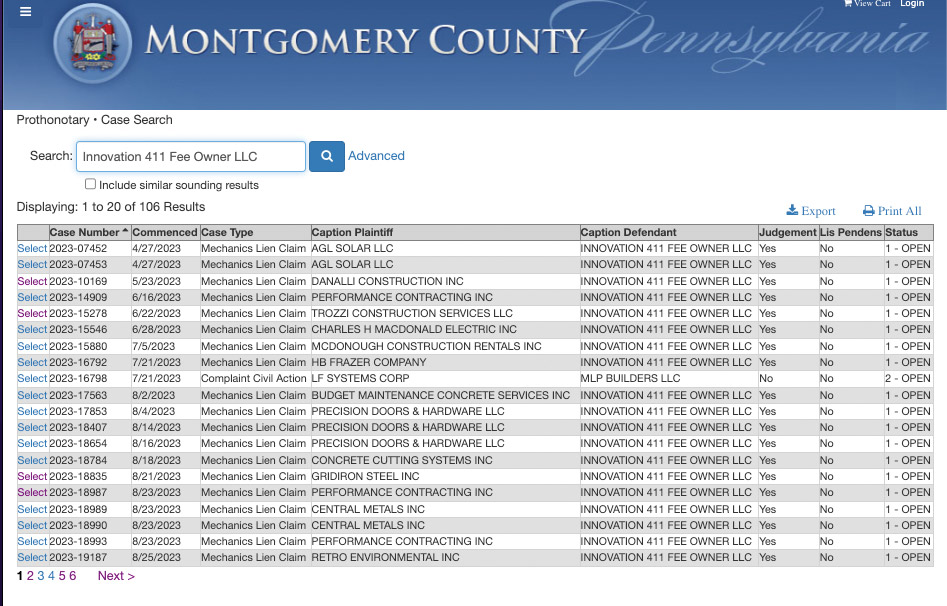Finance
Will Real Estate Developers Soon Hold Back Even More Payments?
February 15, 2024
Finance
Will Real Estate Developers Soon Hold Back Even More Payments?
February 15, 2024The address of San Francisco's Sharon Building, 55 New Montgomery Street, is well known.
Original photo by Schill (Scott Schiller) under the license cc BY-SA 2.0 DEED, image has been cut out, cropped and recolored
If buildings could talk, the elegant Sharon Building at 55 New Montgomery St. in San Francisco would have stories to tell. Built in 1912 in the Chicago School architectural style, it was once filled with architects’ offices and later designated as a landmark. A venerable wood-paneled pub with an ornate bar, the House of Shields, is ensconced on the ground floor. Swift Real Estate Partners purchased the 100,000-sq-ft building in 2018 for about $68 million and hired Skyline Construction to renovate areas in 2022.
But following the pandemic office exodus and surging interest rates, Swift sold the building back to its lender in October for only about $15 million—a bad situation for both companies, since Swift had borrowed $71.4 million, according to public records and local news media. Several months later, Skyline Construction filed suit in state court against Swift and the lender, CrossHarbor Capital, for about $4.7 million in unpaid invoices. The contractor claimed Swift had induced the contractors to add work in what became a $13.5-million project. It also said Swift and CrossHarbor had used a small chamber of commerce worth of corporate entities—20 are named in the lawsuit—and “are now moving around their assets and hoping to pay nothing” until “more millions are made when the real estate market improves.”
Exactly how the alleged shell game functions isn’t clear; Skyline and its attorneys declined to elaborate. Swift and CrossHarbor, whose officials and attorneys also did not reply to requests for comment, did respond to the suit in the summer. Swift claimed Skyline either failed to perform, misrepresented what it did or made fraudulent claims that have no merit. CrossHarbor says liens were not properly filed and that it had no role in authorizing construction work.
Construction pay-trouble stories come around again and again, like carousel ponies. The payment process is notoriously complex, collections often require months and funds withheld are often used as a source of finance by companies along the payment chain.
But what has happened to the Sharon Building should be viewed as a small part of an unfolding real estate calamity. Nearly one out of every five square feet of U.S. office space is vacant, reports Moody’s Analytics, topping the previous record of 19.3% set twice in 1986 and 1991. Developers of all kinds have also been battered by high post-pandemic interest rates, with $544.3 billion in commercial mortgage loans, including multifamily ones, coming due this year, says Trepp Commercial, a data firm.
In those conditions, the century-and-a-half-old custom of owners withholding partial payment to protect themselves from contractor default is prone to abuse. For one management consultant already wary of the special risks to contractors posed by developers, it’s better to work for any other type of corporation or government agency than a developer.

Detroit apartment project played role in contractor’s bankruptcy.
Photo by Scott Hilling/ENR
“The U.S. construction industry historically has a slowdown, or cycle of slowdown, on average every 10 years, and commercial property development suffers and sometimes fails during those slowdowns,” says consultant Thomas C. Schleifer. “Because developers have several ways of passing risk to a construction contractor, including retained payments, one that builds for a developer is right there and rolling the dice with the developer” on project success.
Liens can help, others suggest, but not in the short run. Dan Pope, an underwriting senior vice president at Old Republic Surety, made a straightforward assessment on the website of the Construction Financial Management Association. “The process and ability to perfect and enforce those rights may result in payment to the subcontractor only after a drawn-out process,” he wrote. Securing payments for subcontractors “is a few legal steps into the future.”
Not everyone sees more risk in dealings with developers. A lot of work done by Schlouch Inc., a site preparation specialist based in Blandon, Pa., is for longstanding private-sector customers, says Richard F. King, its chief financial officer. “We really have not seen a significant change in the age of receivables, or a big difference in how long companies are holding retainage.”
There are some examples of trouble, however. One involves a developer forcing its contracting team—including numerous small local contractors and suppliers—to join in its financial risks by going unpaid for many months.
MLP Ventures, based in Radnor, Pa., includes a drug and alcohol recovery chain, a cell and gene therapy-focused contractor development firm and a science and health-themed real estate developer. MLP Ventures has successfully developed the Discovery Labs campus in King of Prussia, Pa., in what’s referred to on its website as Cellicon Valley.
On 200 acres adjacent to Discovery Labs, MLP Ventures started a newer, 1-million-sq-ft office, lab and manufacturing facility called Innovation 411.
Although its buildings and infrastructure were completed last year, MLP Ventures still owes for a lot of work. By a count in the Philadelphia Business Journal, the total amount covered by liens filed in Montgomery County, Pa., exceeds $100 million. Among lien amounts filed starting in April are $342,000 by Trozzi Construction Services; $372,000 by Kendall Electric and $478,000 by Charles H. MacDonald Electric.
According to the Journal, MLP Ventures said it is completing a complex $1.1-billion “financing deal” with lenders and is not contesting the contractors’ claims. Brian O’Neill, MLP Ventures’ CEO, is quoted as saying in November: “It’s all teed up and scheduled to close in the next few weeks. Everybody’s in agreement; there’s no acrimony. Everybody knows where they stand.”


A Pennsylvania developer has kept contractors waiting as it arranges new financing.
Screenshots from Montgomery County, Pennsylvania website
*Click on the images for greater detail
One company, LF Systems, a New Castle, Del.-based custom cabinet maker, apparently could not wait. It filed a breach-of-contract and unjust enrichment lawsuit against MLP Ventures in July, seeking $218,000 it says it is owed and tried to collect in 2022 and 2023. MLP has yet to file a response and did not reply to calls or email requesting comment. The president of one firm that only filed a lien, Angela Clemens of Gridiron Steel, said in a December email that it had “not been paid a penny on this project.”
Change orders pose special risks, especially when owners hold back payment for the entire amount. The recent bankruptcy filing of one of Detroit’s longest operating minority-owned contractors, MiG Construction, suggests that change orders played a role in its financial trouble.
In the filing, MiG reports that two private developers owe the firm a combined $3.7 million and that $787,000 is owed for more than 120 days—way past due, and is preventing MiG from paying its subs. One of the developments, an innovative Detroit apartment project called Dreamtroit, involves a $500,000 change order, according to MiG’s request to a New Jersey federal court to block MiG’s surety, Branchville, N.J.-based Selective Insurance Co. of America, from trying to recover funds. At $1.8 million, the surety is among MiG’s biggest creditors.
Some states have acted to add more clarity to their construction retainage statutes. A recent amendment to New York State’s General Business Law caps retainage for private commercial projects of $150,000 or more at 5%, and requires owners to release funds within 30 days after final approval of the work as defined in the contract. Previously, owners could retain “a reasonable amount” until all contractual obligations were met. The amendment also establishes timelines for notifying contractors and subs of specific outstanding contract items required for release of retainage funds.
Another change was enacted last year in Georgia, which reduced its retainage on most non-highway public-sector contracts by half, to 5%. Other reform efforts have encountered roadblocks. In 2023, Oregon’s legislature failed to undo a 2019 requirement for retainage on public and private construction contracts valued at more than $500,000 to be placed in interest-bearing escrow accounts. The proposal was spurred in part by contractor complaints that fees charged by many financial institutions often exceeded the amount of retainage interest, leading to costly claim disputes. The unsuccessful proposal would have replaced escrow with retainage bonds.
Texas attorney Carroll says that while owners and some general contractors may resist changes to retainage regulations, the biggest pushback typically comes from banking lobbyists. “Banks like loaning money, and they like having retainage held because if a job goes sideways, they haven’t put as much money out,” he explains.
Contractors, meanwhile, remain alert to lopsided retainage provisions in contracts, such as one that states that a certain amount of funds will be released when a certain amount of a building is leased.
Pamela Hepburn, acting CEO of Ohio-based OCP Contractors, says she has never agreed to that contract clause. Most of the time, it works as a subcontractor, and Hepburn, a past Construction Financial Management Association chair, says she is comfortable with OCP working on development projects because the company is a sub to so many top-level prime contractors with good pay practices.
But Hepburn is also experienced at spotting what she describes as “tricky stuff,” such as an owner urging a contractor to mobilize and to begin work, saying “‘we have financing on the way.’” Rather than walking away from a job, she says, “we say ‘this is what we can and can’t agree to.’” Hepburn also sometimes reaches out to other CFMA members and asks if they know a particular contractor. Other times, she says, a surety may talk to other contractors about a certain prime, asking, “‘Have you worked with them?’ and I’ll check if that company is a CFMA member because that adds a level of professionalism.”
Back in San Francisco, the Sharon Building’s re-pricing has been portrayed by business writers as part of a reckoning that some believe sows seeds of a real estate turnaround. Contractors can use the turmoil to learn more about protecting themselves, knowing that, sooner or later, real estate developers will inevitably run into trouble—and that payment risk always comes around again.
Ways to Limit Havoc from Retained Payments
In a perfect world, a round of handshakes might be sufficient. But because “things happen,” literally and figuratively, contracts between owners, general contractors and subcontractors typically include retained payment provisions ranging from 5% to 10% of money owed. The payment is a form of security for the quality and timely completion of agreed-upon work.
That in itself may seem like a reasonable arrangement, but reality often clouds the ideal. Even with regulations in most states governing the percentage of withheld funds for public-sector contracts and when funds are to be released, ambiguous provisions and owner-initiated change orders can delay payment to general contractors and, in turn, their subcontractors. Depending on the jurisdiction, contracts for private-sector projects may have no retainage regulations at all.
Retainage sometimes strays from its original intent by serving as a means of cash flow for the owner or general contractor, according to Brian Perlberg, senior counsel and executive director for ConsensusDocs and Associated General Contractors senior counsel.
Retainage laws limiting what can be withheld provide guardrails against abuses. They “are a positive way to make sure the builder isn’t becoming a banker,” he adds. Such laws can be a burden on smaller contractors and trades vendors, who often bear the heaviest burden of delayed payment, particularly those firms that perform early-stage activities. Construction’s days outstanding for payments due are often between 50 and 85 days, and can be longer on large, complex projects.
“Name another industry where a business allows the customer to hold 5% to 10% of the price for one or two years after services are rendered,” says Kimberlee Driggs, president of Rockville, Md., site contractor D2 LLC.
Impact On Cash Flow
Retainage’s biggest impact is on cash flow, she says, explaining that contractually withheld funds typically account for 10% of D2’s annual billings. That requires her company to tap its line of credit to meet payroll and pay vendors.
But because retainage may compound change order arrangements and other receivable challenges for firms operating with limited reserves or access to cash, it’s little wonder “these small businesses fail because they can’t overcome these financial difficulties,” Driggs adds.
She says that while instances of retainage abuse have not increased in recent years, coping with the challenge requires constant vigilance. She cites one Maryland project on which the prime contractor posted a performance and payment bond. Although state law limits retainage to 5% on fully bonded projects, Driggs says, “the owner has held 10% retainage and, to comply with the law, only accepted a bond for 98% of the contract value.”
On a public project where retainage is at the discretion of the owner, D2 posted a performance and payment bond, with the funds held in retainage amounting to about 50% of the value of the remaining contracted work. “That’s why we are very careful and only work with clients that don’t abuse these issues,” Driggs says.
There may also be opportunities for contractors and subs to negotiate retainage amounts and release criteria.
Texas Attorney Brian Carroll adds that it’s imperative for contractors and subs to know the law where they do business, carefully read their contracts and stand up for what they think is fair.
“If you’re in a jurisdiction that limits retainage to 5%, but the owner wants 10%, you need to push back,” he says, adding that some states, such as Washington and Missouri, have options to substitute bonds instead of retainage.
Mechanic’s liens may also be an option for forcing timely payment, particularly for front-end contractors. “It may be two years before that job finishes, and a lot of things can go wrong in that time,” Carroll says.
Negotiating retainage changes “can be challenging, but we do it,” says Richard F. King, chief financial officer for site preparation contractor Schlouch Inc., Blandon, Pa. He adds that sometimes owners and general contractors will be willing to reduce retainage at a certain point, such as substantial completion, although that definition should be closely examined.
When Schlouch is working as a subcontractor, King is able to assess the legal details involved in a project and how funds will flow on the project, making sure to get a copy of the general contractor’s contract. “Understanding and asking questions about when retainage gets released or conditions to receive payment really helps,” he adds.
Perlberg notes, however, that retention and conditions for release need not be inherently contentious.
“Overall, GCs and subs can be aligned on this issue, and mutually agree on things such as the milestones for reaching substantial completion,” he says. “It’s good project management when a reasonable owner, contractor and subcontractor agree on things.”
But Perlberg admits there will still be times when project parties are less than reasonable.
“That’s an age-old tension,” he says.
By Jim Parsons









